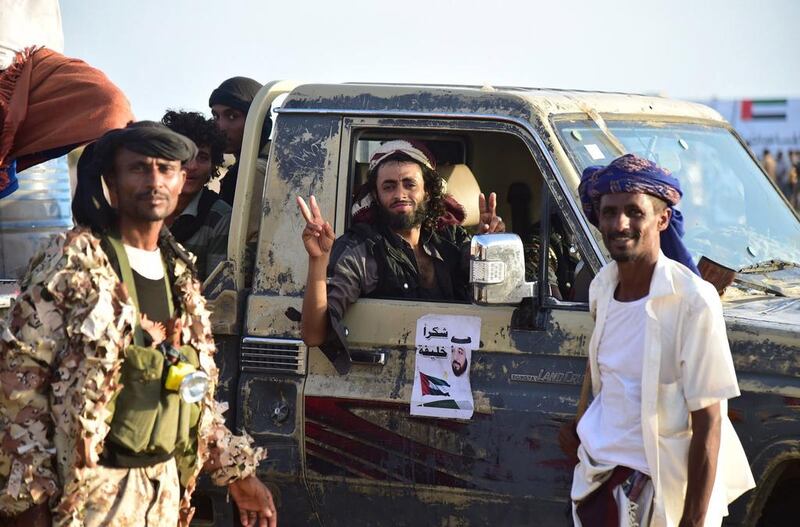ADEN // The Saudi-led coalition dropped arms and ammunition to resistance forces in Taez on Wednesday amid fierce battles with Houthi rebels for control of the province.
Coalition planes parachuted three shipments of arms and ammunition including anti-tank rockets, rocket-propelled-grenade launchers to fighters in Al Dhabab, military and resistance sources said.
“The coalition airdropped weapons early this morning after a message from the resistance that the Dhabab front needed weapons,” said Aref Al Samei, a resistance fighter in the area.
The weapons should provide a crucial boost to the resistance, which is fighting the rebels on several fronts in Taez. The province is key to the coalition’s goal of restoring the government of President Abdrabu Mansur Hadi to power in the Yemeni capital Sanaa.
The drop zone was in the Gabal Habashi district south of Taez city, the provincial capital where resistance fighters and rebels have been battling for control.
The fighters in Al Dhabab had been unable to get weapons or reinforcements from the city because the Iran-backed Houthis and allied renegade units of the Yemeni military control the road.
Gabal Habashi is a centre of the resistance where the deputy leader of the provincial military council, Brigadier Yousef Al Shiragi, is recruiting fighters to send to battlefronts across the province, Mr Al Samei said.
“Brigadier Al Shiragi is responsible for distributing these weapons to the fighters. He knows how to use these weapons and he will teach the fighters to use them well,” Mr Al Samei said.
“These weapons will help us advance in more areas.”
Fierce clashes broke out in Al Dhabab this week after a lull of three months when the rebels targeted civilians in the area, killing women and children.
Mr Al Samei said the resistance in Al Dhabab had received a lot of new recruits recently who were using their own weapons. Most of them lacked combat experience and had only joined to help the resistance liberate their province from the Houthis.
Moa'ath Al Yaseri, a resistance leader in Taez city, told The National that coordinated air strikes by the Saudi-led coalition, in which the UAE is playing a leading role, had helped them to advance on several fronts of Taez, including Dhubab district on the Red Sea coast.
“The coalition forces provided us with weapons in Dhubab but we could not send weapons to the Al Dhabab front as the Houthis control the connecting roads, so the best way was airdropping the weapons,” Mr Al Yaseri said.
The coalition carried out a fresh wave of air strikes on Taez on Wednesday as fierce fighting raged in the city. In the evening, coalition warplanes bombed rebel positions in the west and south of Taez, according to a military source.
A main target was the headquarters of the 35th Brigade, near the central prison and a strategic hill overlooking a residential area.
Meanwhile the Emirates state news agency Wam reported that members of the popular resistance in Yemen were undergoing extensive flight training by the UAE Armed Forces.
The training is being conducted at Al Anad air base, Yemen’s largest, which was rebuilt by the coalition forces after being recaptured from the Houthis. The programme includes training for Yemeni pilots in aircraft used in coalition operations.
Yemeni pilots executed sorties in Taez and Al Bayda to support the resistance and also carried out strikes against targets in the two cities, Wam said, destroying weapons depots and vehicles belonging to the Houthis before returning safely to their bases.
The UAE has also been carrying extensive rehabiliation efforts in southern areas liberated from the rebels. The Emirates Red Crescent (ERC) reported that it has delivered assistance to 91,987 families in Aden and surrounding areas such as Bab Al Mandeb, Shabwa and Abyan.
The relief agancy also sent a convoy of 85 trucks carrying 31,000 food packages to Yemen through the border with Saudi Arabia in the north, and two aircraft carrying 103 tonnes of food supplies and school bags.
An ERC report said it had sent nine aid ships to Yemen before the liberation of Aden in July and three others afterwards. The nine ships were loaded with 18,322 tonnes of food items and materials and machinery to restore public facilities in Aden, which were destroyed in the months of fighting since March to repulse rebels from the city.
The ninth ship, which docked in Aden recently, brought food, clothing, fuel, medical equipment, water pumps, generators, education and health supplies, and 14 trucks. The ERC team is currently working to restore the sewerage network.
The ERC also allocated Dh220 million for generators to restore power supply. It said power stations in Aden were now operating at 90 per cent capacity and 54 more generators were being purchased.
In education, the ERC said it was rebuilding 154 schools in Aden and more than 64 were now ready to open after being fully equipped. Stationery had been given to students who had already started their classes. The total cost of maintenance and reconstruction of schools reached Dh81.3m, the ERC said.
foreign.desk@thenational.ae
* With additional reporting from Agence France-Presse





